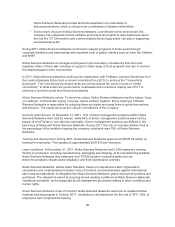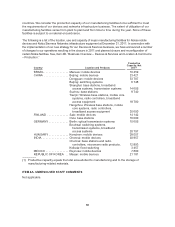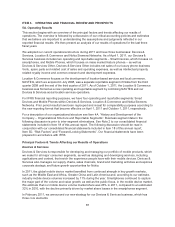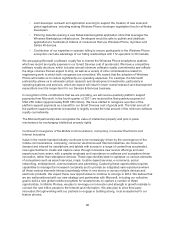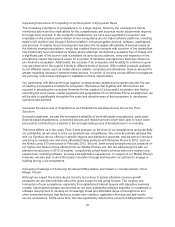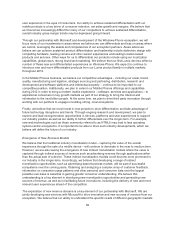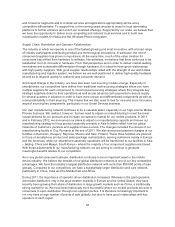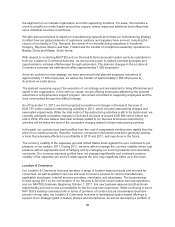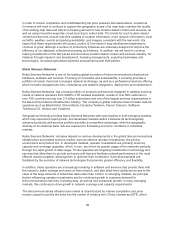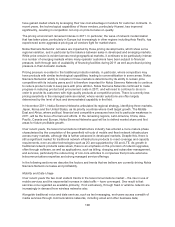Nokia 2011 Annual Report Download - page 94
Download and view the complete annual report
Please find page 94 of the 2011 Nokia annual report below. You can navigate through the pages in the report by either clicking on the pages listed below, or by using the keyword search tool below to find specific information within the annual report.user experience in the eyes of consumers. Our ability to achieve sustained differentiation with our
mobile products is a key driver of consumer retention, net sales growth and margins. We believe that
as it becomes increasingly difficult for many of our competitors to achieve sustained differentiation,
overall industry gross margin trends may be depressed going forward.
Through our partnership with Microsoft and development of the Windows Phone ecosystem, we will
focus more of our investments in areas where we believe we can differentiate and less on areas where
we cannot, leveraging the assets and competencies of our ecosystem partners. Areas where we
believe we can achieve sustained product differentiation and leadership include distinctive design with
compelling hardware, leading camera and other sensor experiences and leading location-based
products and services. Other ways for us to differentiate our products include using our localization
capabilities, global reach, strong brand and marketing. We believe that our first Lumia devices reflect a
number of these new and differentiated experiences on Windows Phone. We expect to continue to
introduce new and more differentiated products from our Lumia product family in multiple markets
throughout 2012.
In the Mobile Phones business, we believe our competitive advantages – including our scale, brand,
quality, manufacturing and logistics, strategic sourcing and partnering, distribution, research and
development and software platforms and intellectual property – continue to be important to our
competitive position. Additionally, we plan to extend our Mobile Phones offerings and capabilities
during 2012 in order to bring a modern mobile experience – software, services and applications – to
aspirational consumers in key growth markets as part of our strategy to bring the Internet and
information to the next billion people. At the same time, we plan to drive third party innovation through
working with our partners to engage in building strong, local ecosystems.
Finally, we believe that we must invest in new projects to drive differentiation and take advantage of
future technology disruptions and trends. Through ongoing research and development, we plan to
explore and lead next-generation opportunities in devices, platforms and user experiences to support
our industry position as well as our ability to further differentiate over the longer-term. For example,
new web technologies such as those commonly referred to as HTML5 may lead to less operating
system-centric ecosystems. It is important to be able to drive such industry developments, which we
believe will define the future of our industry.
Emergence of New Business Models
We believe that the traditional industry monetization model – capturing the value of the overall
experience through the sale of a mobile device – will continue to dominate in the near to medium term.
However, we are also seeing the emergence of new indirect monetization models where the value is
captured through indirect sources of revenue such as advertising revenue through applications rather
than the actual sale of a device. These indirect monetization models could become more prominent in
our industry in the longer-term. Accordingly, we believe that developing a range of indirect
monetization opportunities, such as advertising-based business models, will be part of successful
ecosystems over the coming years. Obtaining and analyzing a complex array of customer feedback,
information on consumer usage patterns and other personal and consumer data over the largest
possible user-base is essential in gaining greater consumer understanding. We believe this
understanding is a key element in developing new monetization opportunities and generating new
sources of revenue, as well as in facilitating future innovations, including the delivery of new and more
relevant user experiences ahead of the competition.
The exploration of new revenue streams is a key element of our partnership with Microsoft. We are
jointly developing new services with Microsoft to drive innovation and new sources of revenue from our
ecosystem. We believe that our ability to understand the specific needs of different geographic markets
92


